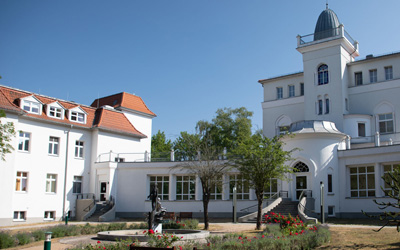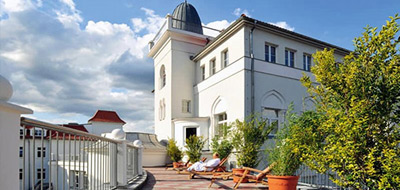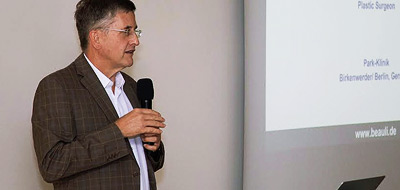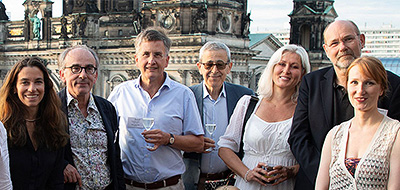The medical profession has been experimenting with the transplantation of autologous adipose tissue (fat grafting) since 1893 (Neuber/Germany). The results range from outstanding to failure, in the worst cases to the formation of calcifications and oil cysts. Human fat cells (adipocytes) are up to 0.2 mm in size and have a life span of about 4 - 6 weeks. Dispersed among them are so-called preadipocytes, which are stem cells from which new fat cells develop. In other words adipose tissue is constantly undergoing a process of renewal.
Since the early 1980s Dr. Sydney Coleman, a plastic surgeon in New York City, has been developing a procedure for the gentle harvesting and transplantation of fat cells. His work has laid the foundations for a successful fat grafting procedure.
Our surgeons in the Department of Plastic Surgery at the Asklepios Klinik Birkenwerder have also been using this procedure on a routine basis since 1999 for grafting smaller volumes of fat, primarily to the face. In March 2007 Dr. Coleman published the results from a number of fatgrafting procedures for breast enlargement in the world’s leading journal for plastic surgery, the "Plastic and Reconstructive Surgery Journal". This article also presents post-operative results up to several years following fat grafting procedures, meaning that it documents actual long-term successes.
The main problem often associated with this method is the very elaborate and time-consuming procedure for harvesting fat cells. The fat cells are harvested by hand using a small, 10ml syringe. The harvested fat is then centrifuged. Through this process approx. 5 ml of fat are obtained. This fat is then transferred to five 1ml syringes and injected into the breast. A breast augmentation performed using this procedure generally takes 4-6 hours.
Inspired by these excellent results and similar findings that have been published by plastic surgeons from Italy and France we have developed a new, even gentler procedure for harvesting fat cells. Our procedure employs the tissue-friendly water-jet assisted (WAL) liposuction technique. We call it the BEAULI™ Method (pronounced “Boly”).
BrEast
AUgmentation by
LIpotransfer
The harvested adipose tissue fragments (small islands of approx. 50-200 adipocytes) are flushed out with water and collected in a sterile collection container, where they are immediately separated from the irrigation fluid. These tissue fragments can then be transplanted using small syringes. The survival of the fat cells depends upon how quickly they are reintroduced into the recipient tissue with a good blood supply. It is vital that the fat not be placed into the recipient site in large clumps but rather distributed in the recipient tissue like strings of pearls in individual fragments of adipose tissue using thin cannulas.
In order to effectively document the results of this operation and help this method become further established as a viable treatment option we are collecting and reviewing all data in the form of a clinical study. A magnetic resonance imaging scan is performed prior to the operation and again after 6 months. We also perform ultrasound examinations and blood tests. To date, more than 200 operations have been performed using our method, all of them with great success. The operations have included purely aesthetic breast augmentations and breast reconstruction surgeries for cancer patients. We have also treated cases of capsular contracture around silicone breast implants by removing the implants and replacing the volume with fat in a single treatment.
A small percentage of the fat cells do not survive the transfer process and are subsequently reabsorbed by the body. An analysis of our MRI (nuclear spin) scans taken prior to and six months following the operations has shown that more than 75% of the fat cells transplanted using the BEAULI™ method “take” and survive. The main risk associated with the use of fat grafting for breast augmentation is the absorption of fat cells that do not survive the procedure. This can lead to the development of oil cysts if a large number of fat cells clump together, and the body is therefore unable to absorb them effectively. This problem can be largely avoided by using the BEAULI™ technique, through which the fat cells are finely distributed in the tissue. In a US study involving 70 patients small calcifications were reported in three to four percent of the patients at their two-year check-up. Mammography results, however, clearly identified these calcifications as benign. In rare cases an infection may develop (immediately following the treatment). Such infections generally respond well to antibiotics. In extremely severe cases the procedure could result in the formation of an abscess requiring surgical treatment or even in breast mutilation. These risks, however, are associated with any surgical treatment involving the breast, even with breast enlargement using silicone implants. To date we have not observed any of these complications in patients treated using our method, which represents a new and genuine alternative to silicone implants. The main advantages are the natural appearance of the treated breasts and the absence of visible scars. Moreover the fat grafting procedure is associated with considerably less pain.
Unfortunately there are many surgeons who have performed – or are performing – fat grafting procedures without observing basic principles for the proper handling of fat cells. Sometimes adipose tissue harvested using standard liposuction procedures is injected directly into the breast using large cannulas. A large percentage of these cells die and excrete liquefied fat. With large clumps of fatty tissue this fat accumulates in quantities that cannot be metabolised. Instead the body isolates these accumulations of liquefied fat by encasing them in connective tissue. These may eventually calcify and show up on mammograms as so-called oil cysts. The development of multiple calcifications may even lead to hardening of the entire breast. We have given our method its own name in order to make it clearly distinguishable from other methods.
The advantages lie in the fact that the fat can be harvested (liposuction) and transferred (fat grafting) during a single operation. The entire procedure takes less than two hours. Furthermore the vitality and the integration rate of the fat cells harvested using this gentle method are very good. The entire surgery can be performed on an outpatient basis under local anaesthesia and light sedation.

Specialist Clinic for Plastic and Aesthetic Surgery
Hubertusstraße 22
16547 Birkenwerder
Germany
Phone: +49 3303 513 4000 0
Email: info@beauli.de
www.park-klinik-birkenwerder.de

The academy will take place in Birkenwerder,
Park Klinik Birkenwerder
Hubertusstrasse 22
16547 Birkenwerder

Discover the art of aesthetic enhancement and reconstruction at our Life Surgery event, presented by leading specialists.
More info »
Meet renowned experts in the field of aesthetic and plastic surgery at the BEAULI™ academy.
More info »